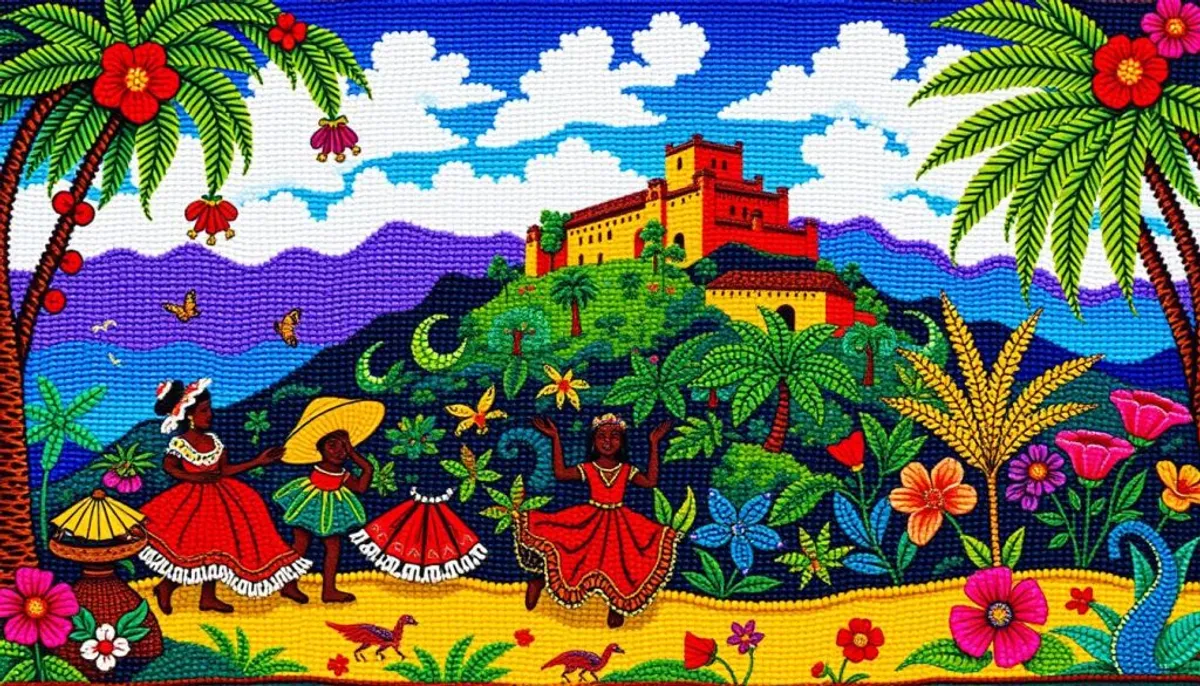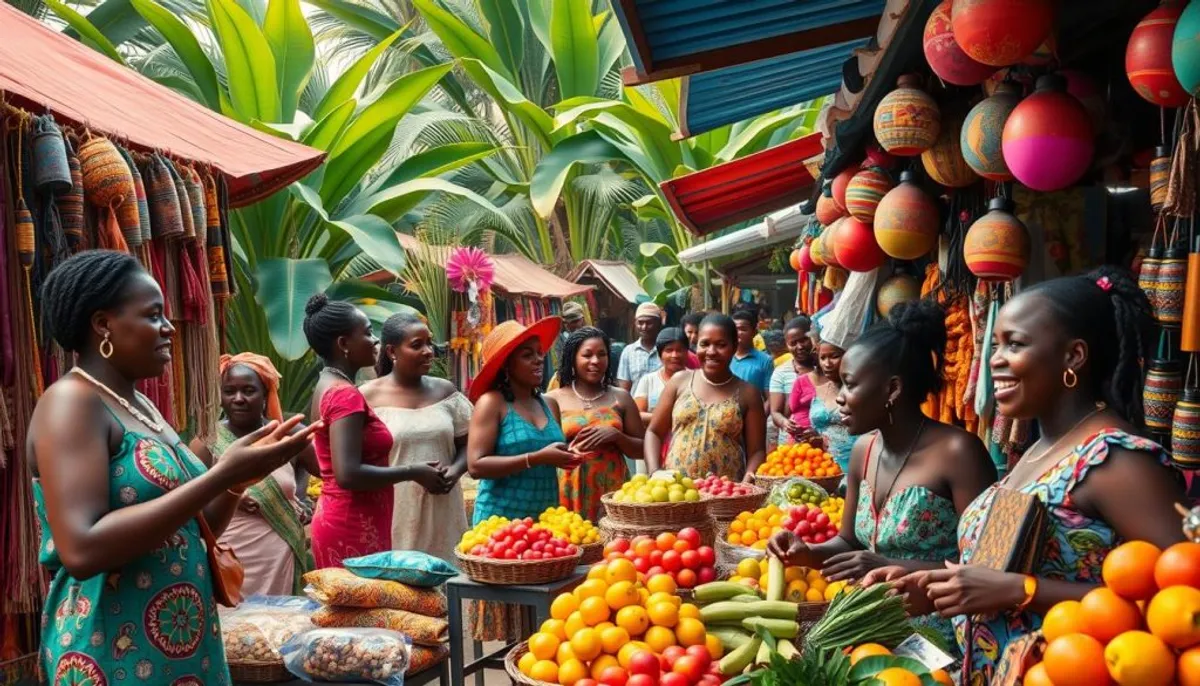The Haitian heritage, a true fabric of diversity, is the result of an unprecedented fusion of African, Taíno, and European influences. This cultural richness deeply permeates the lives of its 11 million inhabitants, shaping their daily identity.

The cultural mixing of Haiti is revealed through its language, music, religion, and traditions. The Haitian Creole, spoken by 98% of the population, illustrates this unique historical heritage. Haitian music, with its varied genres like Kompa and root rhythms, blends influences to create an unprecedented sound.
Haitian visual art is distinguished by the use of bright colors. Literature, on the other hand, explores patriotic themes and values the Creole language. Haitian cuisine, with dishes like national rice, illustrates the fusion of flavors from the different peoples who have inhabited the island.
What is Haitian culture: origins and influences
Haitian culture results from a rich and complex mix. It finds its roots in the island's history, influenced by various traditions. These influences have shaped a unique cultural identity.
The African and European heritage
The African influence dominates Haitian culture. African slaves introduced their traditions and beliefs, deeply rooting themselves. The European heritage, especially French, has also marked the culture, particularly in language and customs.
The influence of the Taínos
The Taíno culture, although less visible today, has influenced Haitian identity. The Taínos left traces of their way of life and worldview. These elements persist in some local traditions.
The unique cultural mixing
The blend of these influences has created a distinct Haitian culture. This mixing is seen in art, music, cuisine, and religious practices such as Vodou. Haiti's independence in 1804 reinforced this unique cultural identity.
| Cultural Element | Main Origin | Contemporary Expression |
|---|---|---|
| Creole language | African and French | Official and popular language |
| Vodou | African | Widespread religious practice |
| Naïve art | Taíno and African | Globally recognized artistic style |
Haitian culture is rich and diverse. It manifests in its 10 departments, each contributing uniquely. The Centre department, for example, with its 678,626 inhabitants in 2009, is known for its resilience in the face of natural disasters and for its traditional customs. This illustrates the strength of the Haitian people.
The languages and cultural identity of Haiti
The linguistic diversity of Haiti illustrates its complex history and distinct cultural identity. The country is characterized by an official bilingualism, combining Haitian Creole and Haitian French. This blend creates a rich and fascinating linguistic landscape.

Haitian Creole as the main language
Since 1987, Haitian Creole has been recognized as an official language. It is the mother tongue of more than 90% of the Haitian population. Originating from the crossing of diverse cultures, it now has over 13 million speakers. The publication of “Dézafi” by Frankétienne in 1975 marked a turning point in Creole literature.
French in Haiti
Haitian French, although official, is less spoken. Less than 10% of the population speaks it fluently. It is primarily used in administration and education, creating social and economic barriers.
Bilingualism in Haitian society
Bilingualism in Haiti is a complex reality. Creole is omnipresent, but French retains prestige. This unique linguistic situation profoundly shapes Haitian cultural identity.
| Language | Status | Percentage of speakers | Areas of use |
|---|---|---|---|
| Haitian Creole | Official | >90% | Daily communication, media |
| Haitian French | Official | Administration, education |
Promoting Haitian Creole in institutions and education would strengthen social cohesion. It would preserve Haiti's unique cultural identity. The challenge is to reconcile this linguistic richness with the development challenges of the country.
Religious and spiritual traditions
Haitian spirituality presents itself as a complex fabric of beliefs and practices. The religious landscape of the country is dominated by two main forces: Haitian Vodou and Christianity. This unique coexistence generates a religious syncretism deeply rooted in Haitian culture and identity.
Haitian Vodou
Haitian Vodou, an ancestral spirituality, finds its origins in African traditions and African influences. Historically marginalized, it has been officially recognized as a religion since the 1980s. This practice combines elements of Catholicism with African beliefs, creating a complex and unique faith system.
Christianity in Haiti
Christianity, primarily Catholicism and Protestantism, plays an essential role in Haitian religious life. Churches serve as gathering places for many Haitians. They play a crucial role in the community and spiritual life of the country.
The coexistence of religious practices
The coexistence of Vodou and Christianity in Haiti illustrates religious syncretism. This unique fusion manifests in the art, music, and daily practices of Haitians. Elements of Vodou appear in Christian celebrations, and vice versa, reflecting the richness and diversity of Haitian spirituality.
Haitian art and literature
Haitian naïve art and Francophone literature of Haiti constitute a rich and varied cultural heritage. Haitian painters are characterized by works with bright colors and mystical themes. Since the mid-20th century, they have gained international recognition.

Haitian literature, among the oldest in French, has undergone significant evolution. The Cénacle, founded in 1836, marked the beginning of the Haitian literary school. Figures like Jacques Roumain, Jean Price-Mars, and René Depestre have shaped the literary identity of the country.
The themes of identity, history, and resistance dominate Haitian literature. Realism and engaged poetry are favored genres. The richness of this literature is manifested in both French and Creole, reflecting the bilingualism of Haitian society.
Haitian visual art encompasses painting, sculpture, and crafts. The influences of Vodou and oral traditions are reflected in these artistic expressions. They create a unique cultural mixing. Oral transmission is essential for preserving traditional narratives and Haitian folk tales.
Despite the absence of science fiction, Haitian literature continues to evolve. Authors like Gary Victor introduce new genres, enriching the Haitian literary landscape.
Traditional music and dance
Haitian music and traditional dance mirror the cultural diversity of the country. It integrates French influences, African rhythms, and Spanish elements. This fusion creates a distinct and rich musical identity.
Kompa and its variations
The kompa, an emblematic genre of Haitian music, emerged in the 1950s. Jean-Baptiste Nemours is its creator, with a slow and captivating rhythm. This style uses a variety of instruments, including brass, guitars, and drums. Artists like Carimi and Tabou Combo have contributed to its popularity beyond Haiti.
Root rhythms
The root rhythms draw inspiration from Vodou spirituality and Haitian folklore. The rara, played during Lent, is distinguished by the use of bamboo trumpets and percussion. The twoubadou, on the other hand, is a rural music that addresses social themes, with instruments such as the guitar and banjo.
Traditional instruments
Haitian music is distinguished by its traditional instruments. Drums play an essential role in Vodou ceremonies and celebrations. The tcha-tcha, manouba, and bamboo trumpets enrich Haiti's sound palette, offering a unique musical experience.
| Musical Genre | Characteristics | Main Instruments |
|---|---|---|
| Kompa | Slow, melodic rhythm | Guitars, drums, brass |
| Rara | Lenten, festive music | Bamboo trumpets, percussion |
| Twoubadou | Songs about daily life | Guitar, banjo, tcha-tcha |
Haitian gastronomy
The Creole cuisine of Haiti is a true culinary treasure, reflecting a rich and varied history. Haitian dishes result from a unique blending of Taíno traditions, French, Spanish, and African influences. This fusion has created a colorful and flavorful gastronomy, famous for its generous seasonings and often spicy dishes.
Iconic dishes
Haitian cuisine is distinguished by iconic specialties. National rice, often accompanied by beans, is one example. The pumpkin soup, traditionally served on New Year's Day, symbolizes the country's independence. The griot, a tasty fried pork, is enjoyed with fried plantains. The rice with djon-djon, with its characteristic black color, surprises with its flavor. These dishes, passed down from generation to generation, embody the art of good taste in Haitian style.
Culinary influences
The richness of Haitian gastronomy comes from its multiple culinary influences. The Taínos introduced the use of local products. French and Spanish colonists brought their cooking techniques. The African heritage is manifested in many preparations, such as tchaka, a nourishing stew. This diversity of origins is reflected in every dish, offering a unique tasting experience.
Traditional beverages
The traditional beverages of Haiti perfectly complement this rich gastronomy. Barbancourt rum, recognized worldwide, and Prestige beer, awarded internationally, are the pride of the country. Lovers of local flavors will enjoy mabi, acassan, or the creamy crèmasse. These beverages, like the cuisine, testify to the creativity and expertise of Haitians in gastronomy.
RelatedRelated articles


